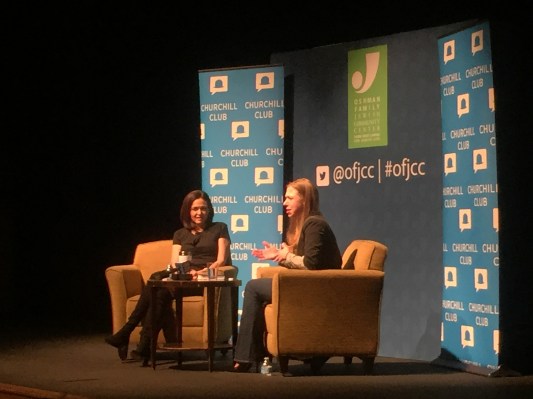Joining Facebook COO Sheryl Sandberg onstage Monday in Palo Alto, Chelsea Clinton said she wanted to see the private sector and government work together to show girls they can grow up to be like Sandberg and Mark Zuckerberg.
In recent years, high-profile sexual harassment lawsuits and diversity reports have put an increased spotlight on the dismal numbers of women working in tech roles at Silicon Valley firms. Both Sandberg, the author of “Lean In,” and Clinton, vice chair of the Clinton Foundation, have emerged as advocates for women’s rights in the workplace and education.
In a discussion about Clinton’s new book aimed at middle schoolers, “It’s Your World,” Sandberg asked Clinton about the gender gap “crisis” occurring in tech. Clinton said it’s discouraging to see the ratios of women in computer science declining, even though the educational opportunities in the field are increasing.
She said even as “the denominator” of tech jobs booms, the percentage of women in the field has sharply declined since she unwrapped her first Commodore computer from Santa Clause in 1987. She said in the mid-1980s, women made up about a third of the field. When she graduated from Stanford University in 2001, Clinton said women made up a little less than one-fourth of the computer science field. Now that number has dropped to less than one in five.
“I don’t think we’re going to live in the future that any of us want to live in if we exclude half of our potential and our promise,” Clinton said. “I think that’s pretty self evident.”
Clinton commended Silicon Valley companies like Google for investing in the talent pipeline to ensure more girls are exposed to STEM studies. She also noted that recent efforts by China to recognize women in STEM shows tech’s gender gap is an issue of national importance.
Sandberg explored the unconscious biases that begin in childhood that deter women from “leaning in” at their workplaces in her 2013 bestseller. Clinton said the challenges for girls in STEM start in middle school. Around fourth grade, girls start imposing themselves in stories about others rather than creating their own stories about themselves, she said.
“So if you’re seeing yourself only as a princess or only as defined as the relationship you have with your father or to your brother or to someone you work for, it’s hard to continue that energy of sharing your own story or continue to imagine yourself as real innovator — which is what so much of technology is really about,” Clinton said.
For Clinton, closing the gender gap has become deeply personal. She has a one-year-old daughter who she wants to see have equal opportunities and be whoever she wants to be. She said she’s going to have to fight the urge to overcorrect for gender inequality as a parent.
“I have to be okay if my daughter just only wants to wear pink dresses,” Clinton said. “That’s going to be fine.”
Clinton and Sandberg spoke to several hundred people — many elementary and middle school girls — at the Oshman Family Jewish Community Center. Sandberg concluded the event by asking the children in the audience to make a silent pledge to start working toward fixing one problem they see in the world.
After the event, a line of young girls snaked around the auditorium entrance waiting for Clinton to sign their new books.
